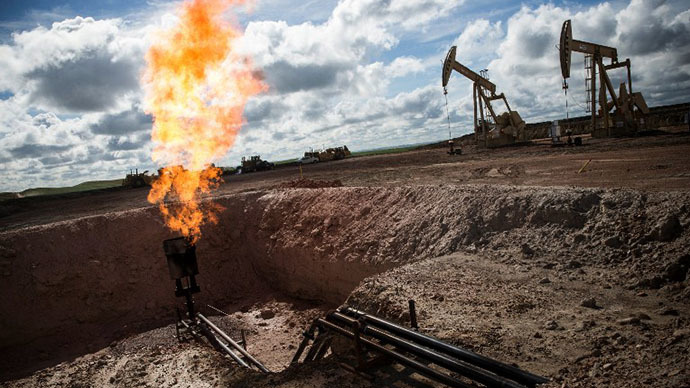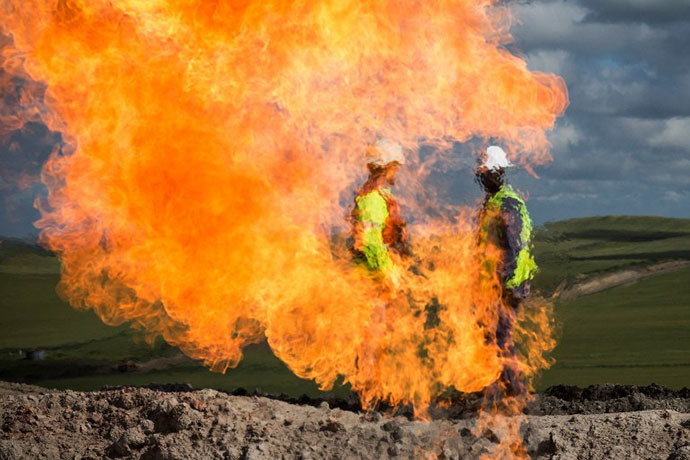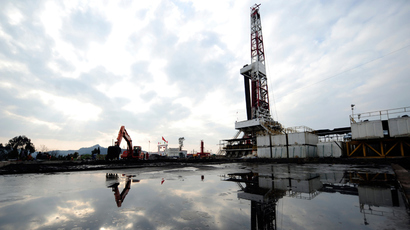The crude truth: American drillers burn $100 million worth of natural gas into thin air

Each month, oil drillers in North Dakota’s Bakken shale fields lose nearly a third of all gas extracted in a practice known as ‘flaring’, the controversial burning raw natural gas, usually methane, because it is cheaper than processing it.
Gas flares are used when excess flammable gasses are released while drilling for oil and natural gas, but are also a method of jettisoning ‘extra’ gas, and is widely regarded as detrimental to the environment, as methane is a gas that contributes to climate change.
North Dakota’s oil boom arrived suddenly, so the oil industry infrastructure of transport and pipelines isn’t yet developed across the state. As a result, excess flammable gasses are released in ‘flares’, Reuters reported, citing a to-be released report by Ceres, a non-profit environmental group.
"There's a lot of shareholder value going up in flames due to
flaring," Ryan Salmon, author of the report, told Reuters.
"Investors want companies to have a more aggressive reaction to flaring and disclose clear steps to fix the problem," Salmon added.
The US Department of Mineral Resources reported that 29 percent, or more than 26 billion cubic feet of gas produced in May was flared. In September 2011, an all-time high of 36 percent of gas was flared.
The flaring practice has tripled in the past three years, according to Ceres.
Oil can be stored in tanks after it is extracted, but natural gas must be immediately piped and sent to a processing facility, or, be flared.
The North Dakota crude oil production was worth $2.21 billion in
May, so the ‘waste’ is only a fraction of revenue and
profit.
With more than 266,000 million cubic feet flared each day in North Dakota, that's roughly $3.6 million in lost revenue, more than $100 million per month.
"We all understand that the flaring is an economic waste,"
Ron Ness of the North Dakota Petroleum Council, told Reuters.

Lost Cost
If a better transport infrastructure system existed in the vast 18,000 square mile Bakken reserve fields, ‘flaring’ wouldn’t be necessary as companies could ship the natural gas for processing.
The Canadian oil train that derailed was traveling from North Dakota’s Bakken oil region to New Brunswick, which re-sparked the debate for pipelines in North Dakota.
US railroads already carry 1 million barrels of crude per day, and proponents of the Keystone XL pipeline pointed to the crash as evidence the energy transport grid needs to be overhauled.
Multiple companies have proposed pipeline projects in the region to increase site productivity and reduce flaring, which would ameliorate oil operators, investors, and owners.
The growing volume of gas being produced in the Bakken fields in North Dakota means the need for quicker site-to-site transport of the state’s 9,000 wells is growing, as the number of wells is projected to expand to 50,000 by 2030.
In Texas and Alaska, which have a well-developed energy infrastructure, less than 1 percent of natural gas extracted with oil is ‘flared’, Reuters reports.
Presently North Dakota is more focused on oil production. Output in the Bakken fields has grown from 10,000 barrels per day to nearly 800,000 a day in the last 6 years. The US produced 7.56 million barrels of crude per day in the third week of July, the highest level since 1990, according to EIA figures.
Oil production remains king in North Dakota, outpacing the amount of natural gas extracted and funding many infrastructure projects. Yet production of natural gas likely will double by 2025, which could increase flaring.
The US has 890 trillion cubic feet of recoverable natural gas reserves, enough fuel for nearly 40 years based on current consumption habits, Bloomberg reported.
The flaring of associated gas may occur at the top of a vertical flare stack (as in the adjacent photo) or it may occur in a ground-level flare in an earthen pit.














